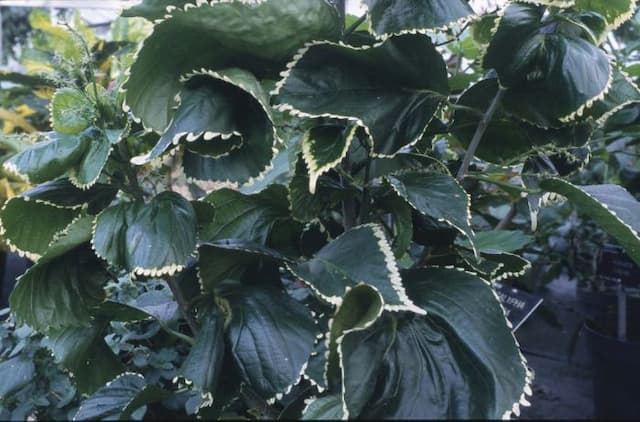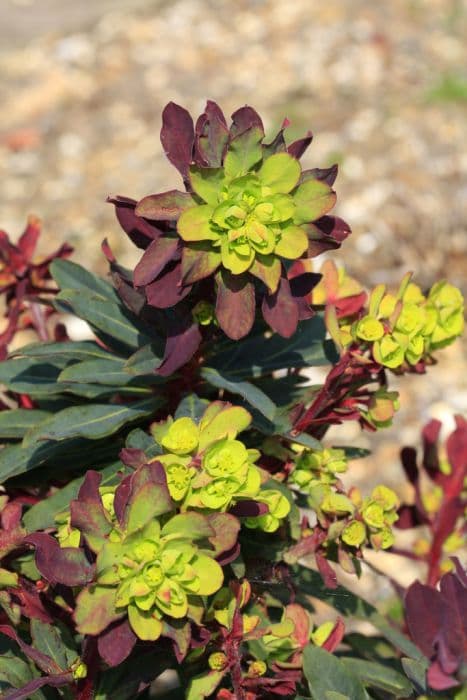Spurge 'Purple and Gold' Euphorbia characias subsp. wulfenii 'Purple and Gold'

ABOUT
'Purple and Gold' is an evergreen subshrub or shrubby perennial to around 1.5m tall. Leaves are a dull green in summer but turn purple in autumn and winter. Large, bright yellow and green flowerheads are borne from spring into summer
About this plant
 Names
NamesFamily
Euphorbiaceae
Synonyms
Mediterranean Spurge, Wulfen Spurge
Common names
Euphorbia characias subsp. wulfenii 'Purple and Gold'.
 Characteristics
CharacteristicsLife cycle
Perennials
Foliage type
Evergreen
Color of leaves
Blue-green
Flower color
Yellow-green
Height
4 feet (1.2 meters)
Spread
3 feet (0.9 meters)
Plant type
Shrub
Hardiness zones
8
Native area
Mediterranean
Benefits
 General Benefits
General Benefits- Ornamental Appeal - Euphorbia wulfenii 'Purple and Gold' is prized for its striking foliage and vibrant, long-lasting flowers that add aesthetic value to gardens and landscapes.
- Drought Tolerance - This plant is highly drought-tolerant, making it an ideal choice for xeriscaping and low-water-use gardens.
- Low Maintenance - Euphorbia wulfenii 'Purple and Gold' requires minimal care once established, needing only occasional pruning to keep its shape and remove spent blooms.
- Pest Resistance - The plant has a natural resistance to many pests, reducing the need for chemical pest control.
- Deer Resistant - Its sap and texture make it unappealing to deer, which can be beneficial in areas where deer browsing is a problem for gardeners.
- Seasonal Interest - It provides year-round interest with its evergreen foliage and seasonal blooms, helping to maintain an attractive garden throughout the year.
- Attracts Pollinators - The flowers of Euphorbia wulfenii 'Purple and Gold' attract pollinators such as bees and butterflies, contributing to the health of the local ecosystem.
- Soil Adaptability - This euphorbia variety can thrive in a wide range of soil types, as long as they are well-draining, making it a versatile plant for different garden conditions.
- Structural Plant - With its architectural form, it can serve as a focal point in garden design or as part of a mixed border for structural interest.
 Medical Properties
Medical PropertiesThis plant is not used for medical purposes.
 Air-purifying Qualities
Air-purifying QualitiesThis plant is not specifically known for air purifying qualities.
 Other Uses
Other Uses- Euphorbia characias 'Purple and Gold', also known as Mediterranean Spurge, can be used in dried floral arrangements due to its unique and long-lasting flower structures.
- In garden design, Mediterranean Spurge can provide a striking contrast when used as a backdrop for plants with darker foliage due to its bright green and yellow hues.
- The milky sap of Mediterranean Spurge has traditionally been used as a fish poison in some cultures, taking advantage of the toxic qualities to stun or kill fish.
- The structure of Mediterranean Spurge can offer shelter and a micro-habitat for beneficial garden insects like ladybugs that help control pest populations.
- When planted in large numbers, Mediterranean Spurge can be used to stabilize soil on slopes and prevent erosion with its extensive root system.
- Mediterranean Spurge can serve as a natural seasonal indicator because its blooming period can help signal the transition from winter to spring in temperate regions.
- Some creative landscapers use Mediterranean Spurge in desolate or post-industrial spaces to create an element of visual interest and improve aesthetics without requiring high maintenance.
- Mediterranean Spurge is sometimes used as a conversation starter in gardens due to its unusual appearance and the folklore associated with its toxic sap.
- Professional photographers and hobbyists alike might plant Mediterranean Spurge to create a vivid and structured natural setting for photo shoots.
- The plant's strong architectural form can be used in silhouette garden designs, where it casts interesting shadows during sunrise and sunset.
Interesting Facts
 Feng Shui
Feng ShuiThe Mediterranean Spurge is not used in Feng Shui practice.
 Zodiac Sign Compitability
Zodiac Sign CompitabilityThe Mediterranean Spurge is not used in astrology practice.
 Plant Symbolism
Plant Symbolism- Resilience: Euphorbia characias subsp. wulfenii 'Purple and Gold', commonly known as the Mediterranean Spurge, thrives in harsh conditions and rocky soils, symbolizing the ability to endure and adapt to challenging environments.
- Protection: The milky sap of the Mediterranean Spurge can be toxic and irritant, which translates into a symbolic meaning of protection from harm and negative influences.
- Healing: Historically, some Euphorbia species have been used in traditional medicine, giving this plant a symbolic connection to healing and the soothing of ailments.
 Water
WaterMediterranean Spurge should be watered thoroughly, allowing the soil to dry out slightly between waterings. Generally, you can water this plant every 7 to 10 days, depending on the climate and soil drainage. Provide about 1 gallon of water for a medium-sized plant each time you water to ensure deep soil moisture. During the growing season in spring and summer, you may need to water more frequently. In the cooler months, reduce watering, as the plant requires less moisture when dormant.
 Light
LightMediterranean Spurge thrives best in full sun to partial shade. It is ideal to place it in a spot where it can receive at least 6 hours of direct sunlight daily. Some dappled shade during the hottest part of the afternoon can be beneficial, especially in very warm climates.
 Temperature
TemperatureMediterranean Spurge prefers a Mediterranean climate and can tolerate a wide temperature range. It can survive temperatures as low as 20°F but thrives between 50°F to 85°F. It is not suited for extremely cold climates and can be damaged by temperatures below 20°F.
 Pruning
PruningPruning Mediterranean Spurge helps maintain its shape and encourages new growth. Prune the plant back by about a third in late summer or fall, after the flowering season ends. This timing allows the plant to heal before winter. Deadheading spent blooms during the flowering season can also promote a second flush of flowers.
 Cleaning
CleaningAs needed
 Soil
SoilMediterranean Spurge prefers a well-draining soil mix with sand or gravel for excellent drainage. A soil pH ranging from neutral to slightly alkaline (pH 7.0 to 8.0) is ideal for this plant to thrive. Incorporating organic matter can help improve soil structure, but ensure not to over-enrich as this plant tolerates poor soils.
 Repotting
RepottingMediterranean Spurge does not require frequent repotting and can typically be repotted every 2-3 years. It's best to repot in spring or early summer when the plant is entering a growth phase, and to always use a well-draining soil mix to prevent root rot.
 Humidity & Misting
Humidity & MistingMediterranean Spurge is tolerant of a wide range of humidity levels and thrives best in average room humidity. It doesn't necessitate high humidity environments and can tolerate dry air, making it suitable for typical indoor conditions.
 Suitable locations
Suitable locationsIndoor
Place in bright light; not too moist; coarse, well-draining soil.
Outdoor
Full sun to partial shade; well-draining soil; hardy and drought-tolerant.
Hardiness zone
8-11 USDA
 Life cycle
Life cycleEuphorbia characias subsp. wulfenii 'Purple and Gold', commonly known as Mediterranean Spurge, starts its life cycle as a seed, which after dispersal germinates in favorable conditions of warmth and light. The seedling stage involves the development of a robust root system and the first true leaves. As it enters the vegetative growth stage, it forms a bushy structure with blue-green foliage and begins to develop its characteristic upright stems. During the reproductive stage, usually in late winter to spring, it produces distinctive flowers that have purplish nectar glands surrounded by bright golden-yellow bracts, which attract pollinators for seed production. After pollination and seed set, the plant may go through a period of dormancy during the heat of summer or in response to drought. Finally, as a perennial plant, Mediterranean Spurge will go through multiple cycles of growth and reproduction, though after several years, older plants may become woody and may need to be rejuvenated or replaced.
 Propogation
PropogationPropogation time
Spring to Summer
Euphorbia characias subsp. wulfenii 'Purple and Gold', commonly known as Mediterranean Spurge, is typically propagated through cuttings. This method is most effective when performed in the summer. To propagate by cuttings, a gardener should select a healthy stem and make a clean cut to remove a piece about 6 inches (15 centimeters) long. It is essential to allow the cutting to dry for a few days to form a callus over the cut surface, which helps prevent rot when planted. The callus formation is a critical step given the milky sap of Euphorbias, which can be irritating to skin and mucous membranes. Once callused, the cutting is then inserted into a well-draining soil mix, ideally with the addition of sand or perlite to enhance drainage. Regular watering and providing indirect light will encourage rooting. It usually takes a few weeks for the cuttings to establish a robust root system.



![Spurge [Blackbird]](/_next/image?url=https%3A%2F%2Fplants-admin.emdemapps.com%2Fimages%2Fplants%2F%2Fimages%2F604b535f37783.png&w=640&q=75)





